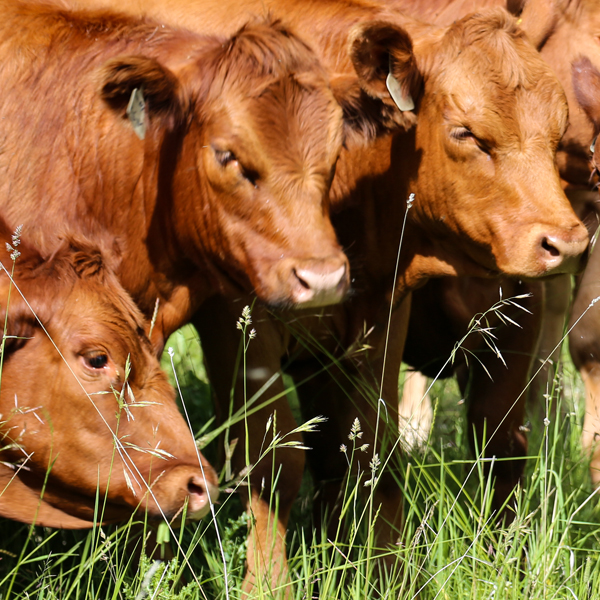
 When people talk about art for a living, they usually mean the highlights—the big launches, the finished pieces, the stuff that looks good on a timeline. But this—the half-finished paintings, the licensing negotiations, the time made for ideas—this is the work.
When people talk about art for a living, they usually mean the highlights—the big launches, the finished pieces, the stuff that looks good on a timeline. But this—the half-finished paintings, the licensing negotiations, the time made for ideas—this is the work.
If you go through any videos, articles, or books about art promotion, you’ll find one consistent theme—be consistent.
It’s easy to promise yourself you’ll write and send a post each week on the same day. Actually doing it? That’s another story.
I’ve been meeting editorial cartoon deadlines every week for more than twenty years. Coming up with ideas isn’t as tough as it used to be, but I still have to draw and send a cartoon, no matter what—whether I’m feeling inspired or not, whether I like the idea or think it’s a dud.
Even though I usually write two or three blog posts and emails each month, there are times when I don’t have much to say. And when that happens, it’s easy to think, “I’ll get to it next week.”
But that kind of procrastination isn’t fair to everyone who’s signed up for this subscription ride, and I don’t take that for granted.
So, with lots in progress but nothing quite finished to share, here’s a bit of a dog’s breakfast of what’s on my desk and on deck.
PAINTINGS
I’m still working on those three cats. That’s normal for commissions—they take time, especially when you’re trying to capture three distinct animals in one piece. But I’ve finally found my groove this week, the fun part.
Thanks to some helpful (and welcome) suggestions from the client, their personalities are coming through. There are two black cats in the painting, each with a different look and vibe, and I was a little worried about pulling that off. That’s where back-and-forth with the client really matters. The more I learn about their features and quirks, the better job I can do.
The cats are now in the same painting rather than separate sketches, and when I open the file now, I don’t clench my teeth. I smile. That’s a good feeling. It’s not unique to this commission either. That’s the usual experience for most of my paintings.
I’m also working on a snowy owl, a grizzly bear, and a raven, all at various stages of completion. There’s a lot more work to do on this one, as I’m also recording the process on video, but here’s a sneak peek at the owl in progress.
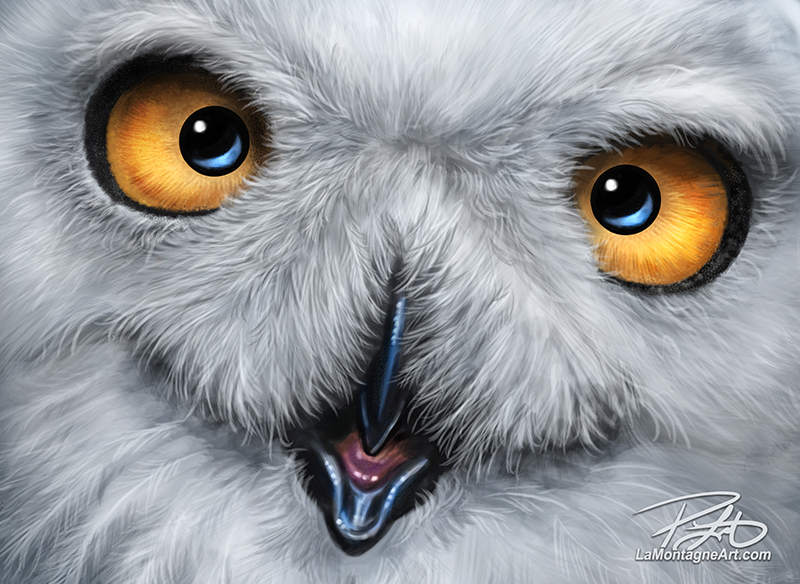
LICENSING
It’s been a good couple of weeks on the licensing front. One international company I’ve worked with before came back with a new proposal. Since my first experience with them was pretty close to perfect, I was happy to jump into a new contract with them.
Another company I’d never heard of cold-called me with a very appealing offer to license my work. We’re in the “crossing t’s and dotting i’s” stage now.
Both companies are seasoned pros when it comes to working with artists. There’s nothing unexpected in the contracts, and most of it is just formality. In my experience, that’s typical. While it does happen, it’s rare to come across a company trying to screw you over.
I realize both of these updates probably sound like teases, but that’s the nature of licensing. I can’t talk about names or details until they launch, which could take weeks, months, or even a year. In the meantime, there’s work to do behind the scenes and it takes real time and effort.
The admin side of being a professional artist often eats up more time than most expect. But licensing is a solid revenue stream because it’s built on artwork I’ve already created, and it works well for me.
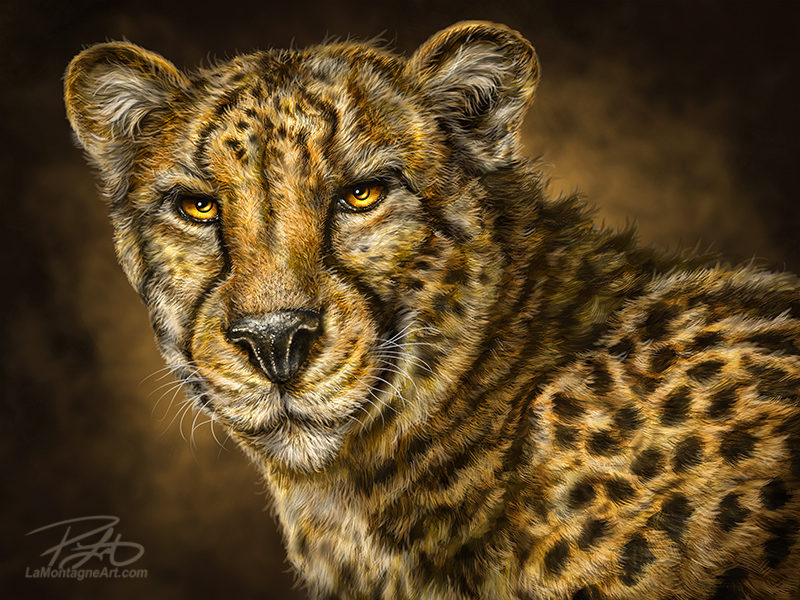 Diamond Art Club just released a new kit featuring my cheetah painting, my sixth kit so far. That one was a surprise, since it’s not one of my more popular prints. But they do plenty of research before launching a new image, and there was a demand for this one. I love working with this company, and there are more pieces in the pipeline. But they decide and let me know when I can share them.
Diamond Art Club just released a new kit featuring my cheetah painting, my sixth kit so far. That one was a surprise, since it’s not one of my more popular prints. But they do plenty of research before launching a new image, and there was a demand for this one. I love working with this company, and there are more pieces in the pipeline. But they decide and let me know when I can share them.
EDITORIAL CARTOONING
A Calgary Herald reader saw one of my recent G7 cartoons and ordered a couple of prints. I don’t get a ton of editorial cartoon orders, but enough that I’ve built a good production system for them. I use the same printer who produces my metal and canvas prints, so the quality is always spot-on.
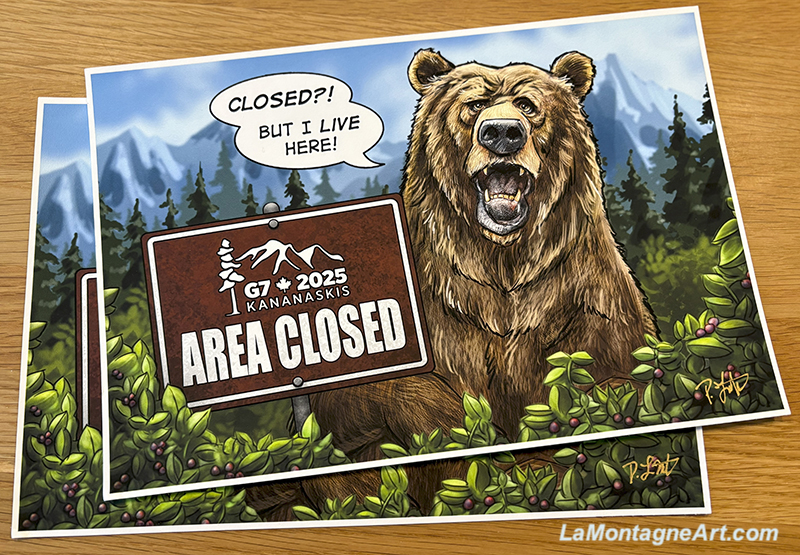 This particular cartoon also featured a grizzly bear—so the best of both worlds. I signed both prints and shipped them yesterday.
This particular cartoon also featured a grizzly bear—so the best of both worlds. I signed both prints and shipped them yesterday.
LIFE STUFF
Last weekend, I got away for a cabin trip with my buddy Darrel. It’s a good thing we book these months in advance—if I didn’t have the commitment (and the deposit), I’d probably find a too-busy excuse not to go. I know, wrong priorities, I’m working on it. Thankfully, once I’m there, it always feels like the right decision.
After years of getting up at 5:00 a.m., I can’t really sleep late anymore. Even without an alarm, and staying up later than usual, I was still up by 6 or 7. I tiptoed past Darrel’s room, showered, made some coffee to-go, and headed out looking for wildlife.

The morning walks were a peaceful start to the day. Critter sightings were limited—just some skittish white-tailed deer, a juvenile Cooper’s Hawk overhead, and cows. Lots of little birds singing in the trees, over a dozen species according to the Merlin app. One evening, a couple of Great Horned Owls were calling to each other. And in the middle of the night, coyotes howled from all directions. That last one is one of my favourite sounds in nature.
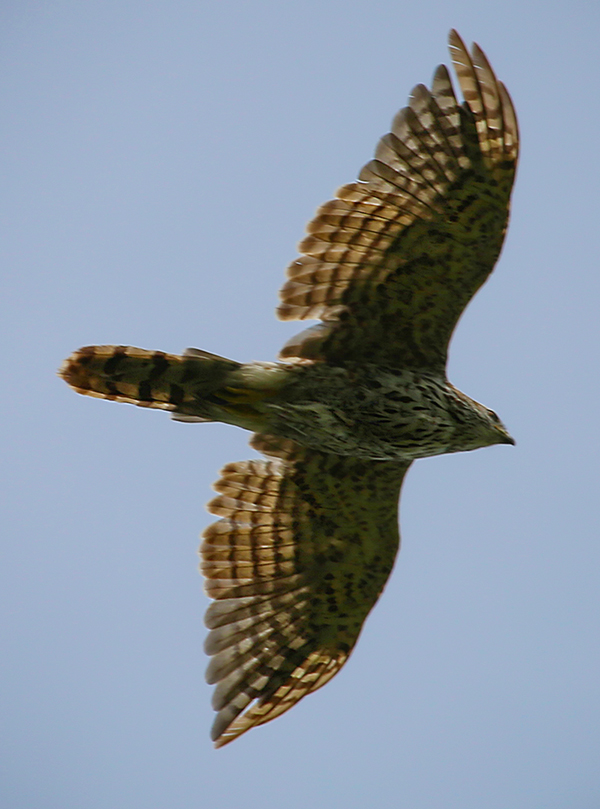 I’m always surprised when I sort through reference photos, because often something I thought I had, doesn’t look as good when I get home. And then a random throwaway photo might spark a painting.
I’m always surprised when I sort through reference photos, because often something I thought I had, doesn’t look as good when I get home. And then a random throwaway photo might spark a painting.
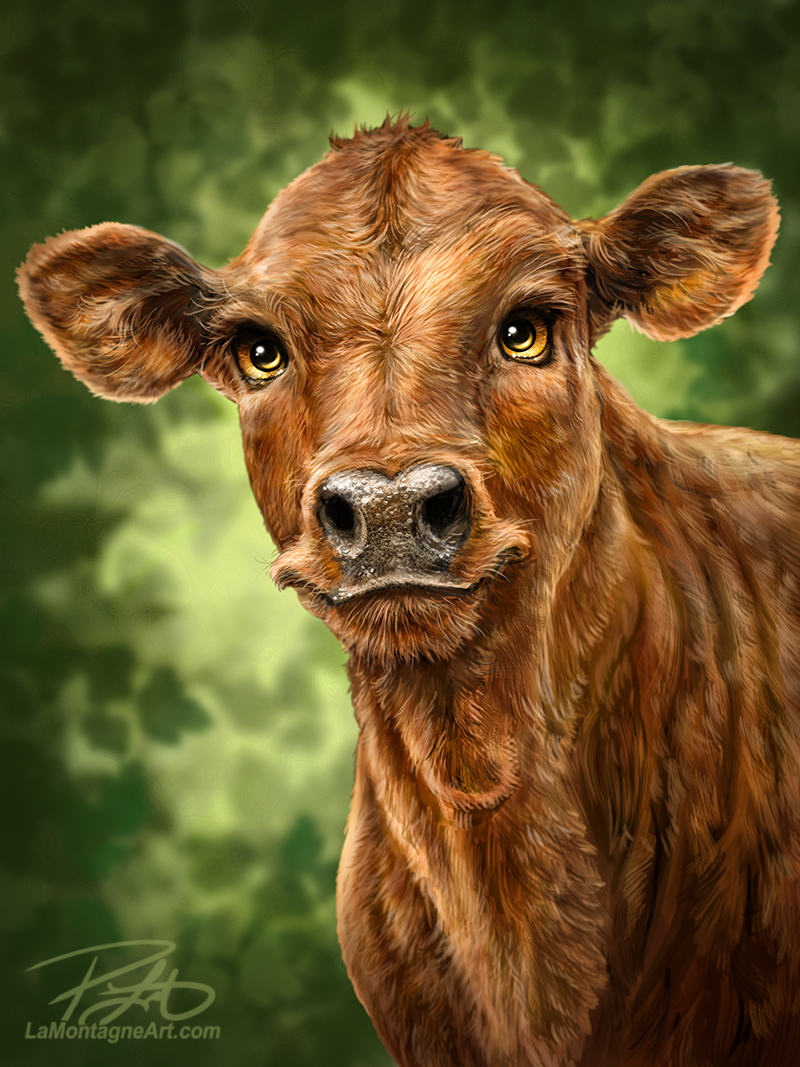 This little calf was painted from reference I took at the cabin a few years ago. I’ve since retired it because frankly it wasn’t popular, even though I enjoyed the work and like the painting. That happens a lot, where my favourites may not be your favourites.
This little calf was painted from reference I took at the cabin a few years ago. I’ve since retired it because frankly it wasn’t popular, even though I enjoyed the work and like the painting. That happens a lot, where my favourites may not be your favourites.
 But one evening on this visit, I noticed the neighbour’s cows hanging around his gate near the road, and shortly after this first pic, they clustered together and it struck me comical. So I took a bunch of photos, and though I’d work from several of the ones I shot, I think there’s a painting here. Already thinking about how long it would take, but this is a marathon, not a sprint.
But one evening on this visit, I noticed the neighbour’s cows hanging around his gate near the road, and shortly after this first pic, they clustered together and it struck me comical. So I took a bunch of photos, and though I’d work from several of the ones I shot, I think there’s a painting here. Already thinking about how long it would take, but this is a marathon, not a sprint.
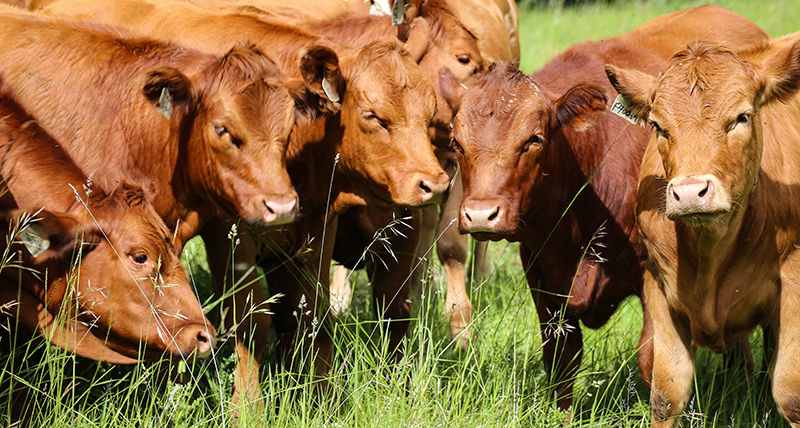 I’ll have to let it simmer a bit, but whenever I hear that voice whisper, “hey, look here,” I try to pay attention.
I’ll have to let it simmer a bit, but whenever I hear that voice whisper, “hey, look here,” I try to pay attention.
We did our usual: cards, games, guitar, napping on the deck, and wandering the property without agenda. We had some (always welcome) on-and-off rain, a loud, windy thunderstorm with a bit of non-damaging hail, but overall, the weather was pleasant.
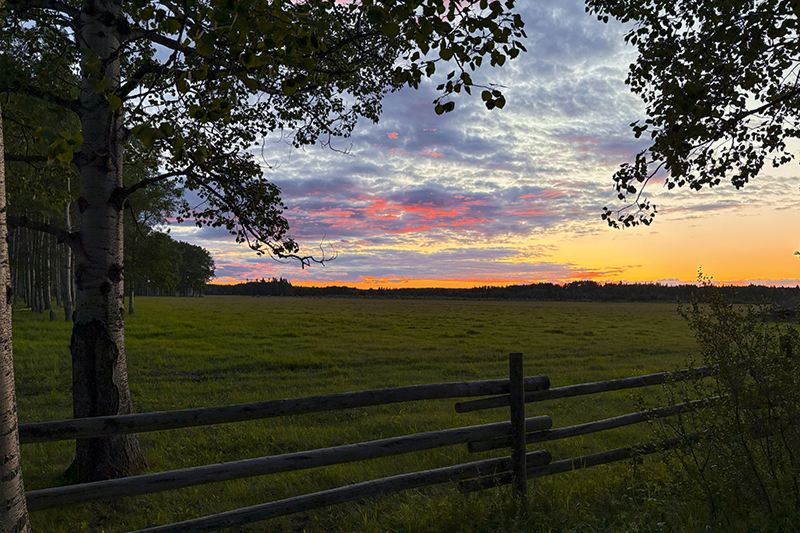 And while I still spent too much time in my own head, thinking about work and worrying about things I can’t control, the setting and company helped me turn down the volume for a few days.
And while I still spent too much time in my own head, thinking about work and worrying about things I can’t control, the setting and company helped me turn down the volume for a few days.
I’ll have some new work to share with you soon.


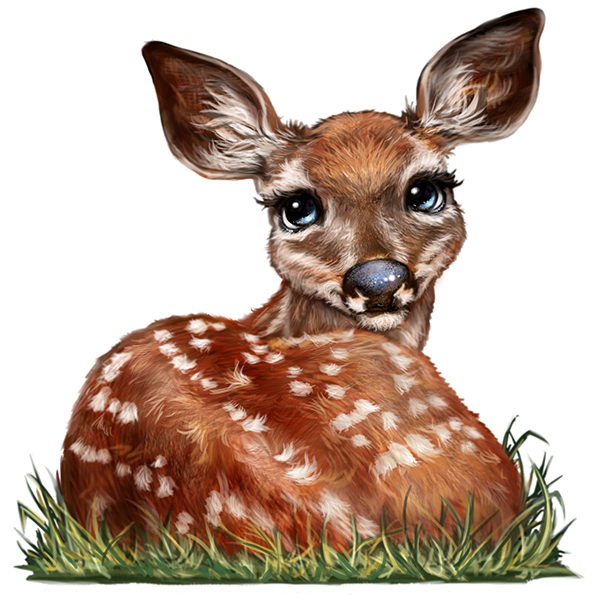
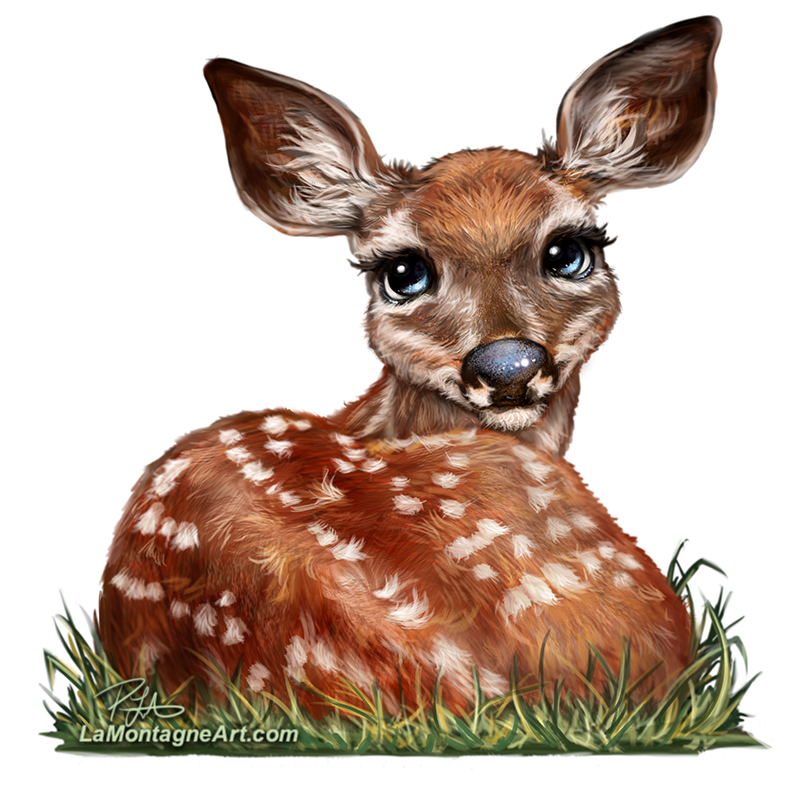 I’ve been working on a commission of three cats, and it’s coming along well. The client has provided some valuable feedback on the images I’ve shared so far. I’ve also recorded a bunch of the process, written the video narrative, and I’m still working on that video and the painting itself.
I’ve been working on a commission of three cats, and it’s coming along well. The client has provided some valuable feedback on the images I’ve shared so far. I’ve also recorded a bunch of the process, written the video narrative, and I’m still working on that video and the painting itself.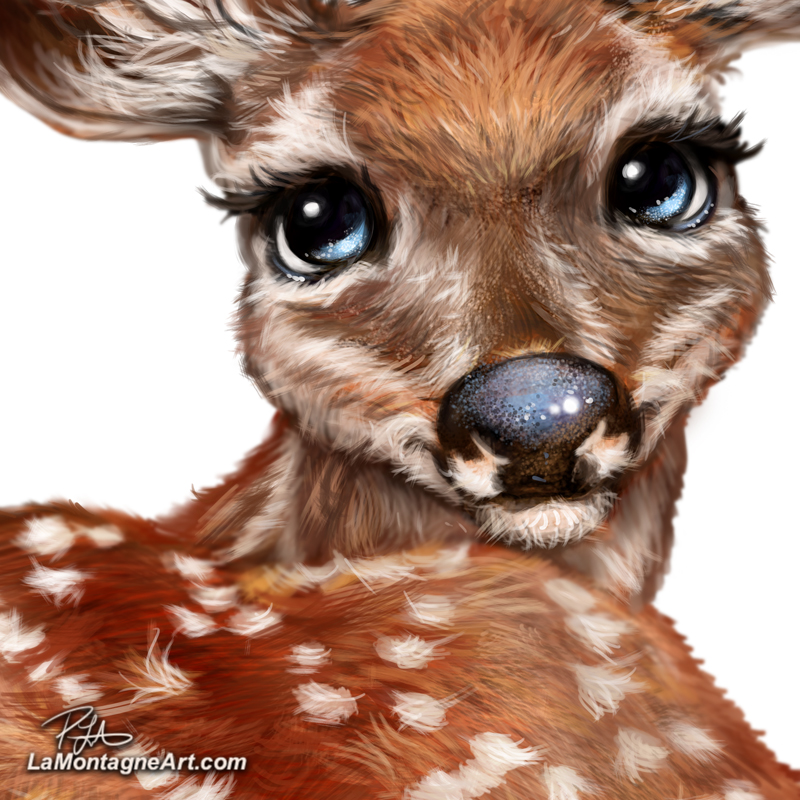 I based this little fawn on reference I shot at
I based this little fawn on reference I shot at 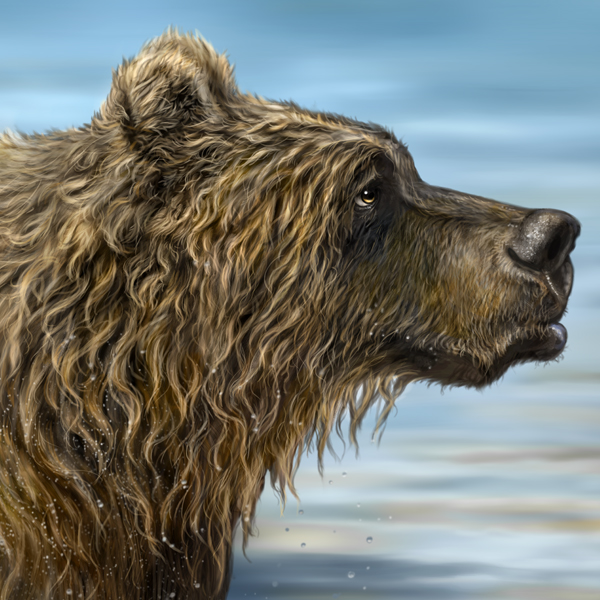
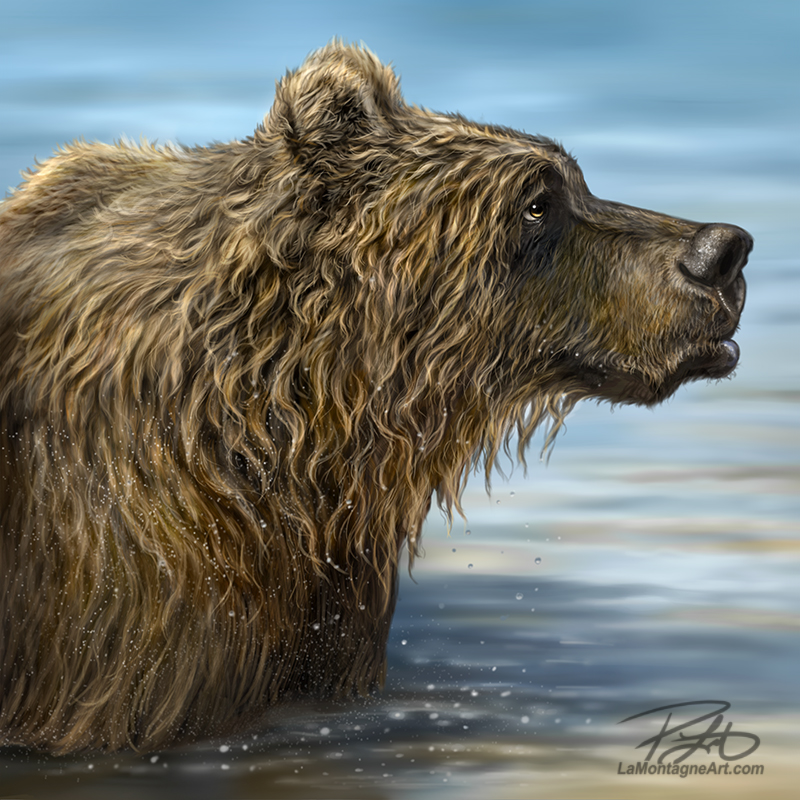 First, here’s a painting I just finished yesterday called Pouty Bear. Even though most of the animals I paint are smiling and happy, I occasionally change them up, even if I know that a different expression may not appeal to people.
First, here’s a painting I just finished yesterday called Pouty Bear. Even though most of the animals I paint are smiling and happy, I occasionally change them up, even if I know that a different expression may not appeal to people.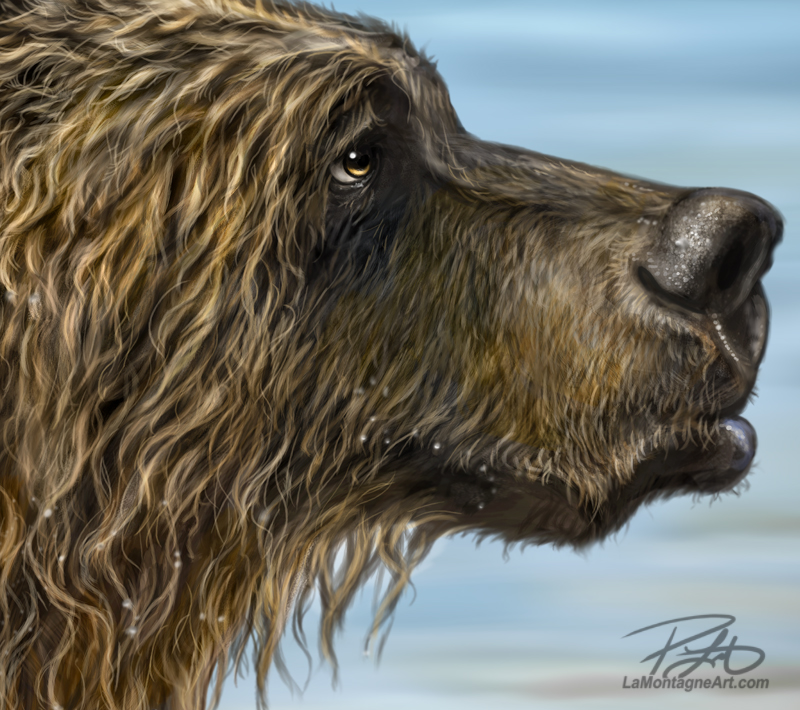 Commissions and Comic-Con
Commissions and Comic-Con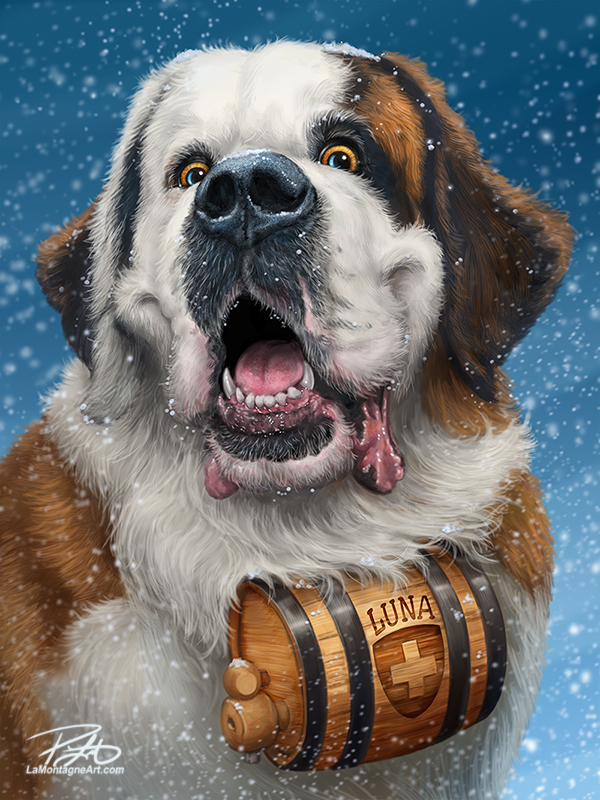
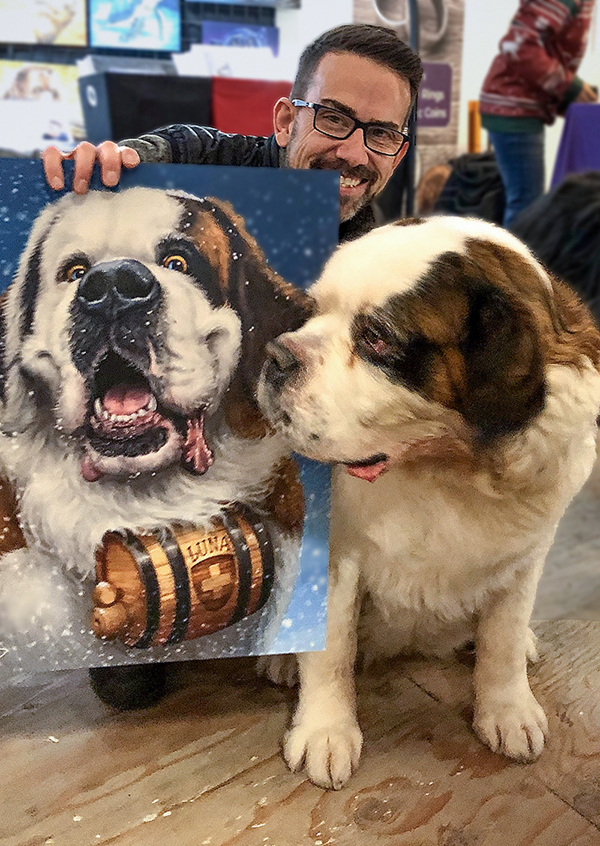
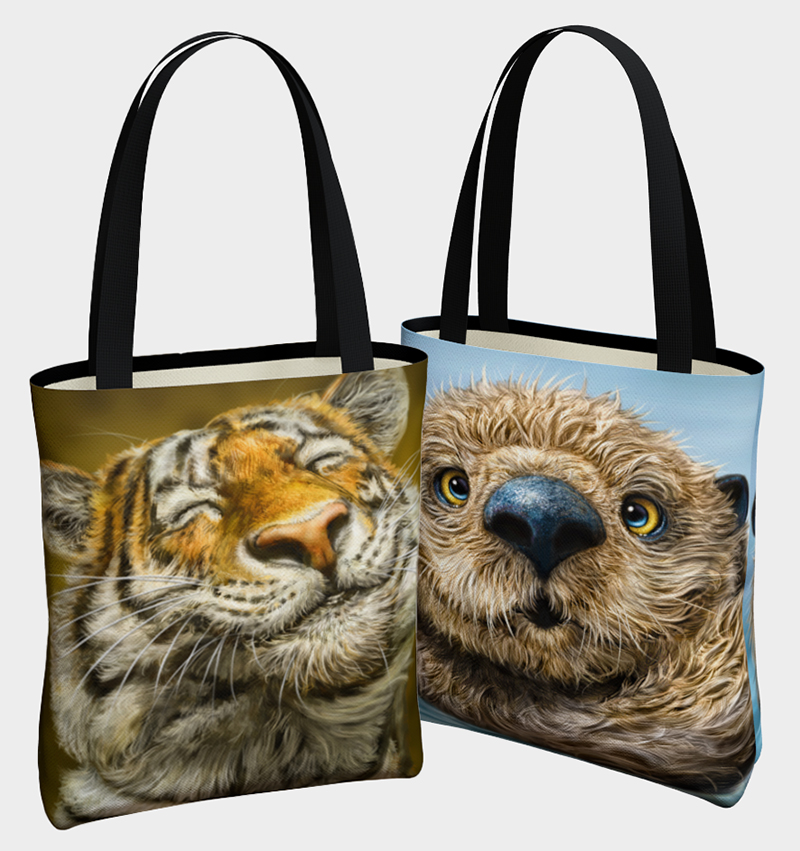 Several people emailed me asking if I’ll have them in the
Several people emailed me asking if I’ll have them in the 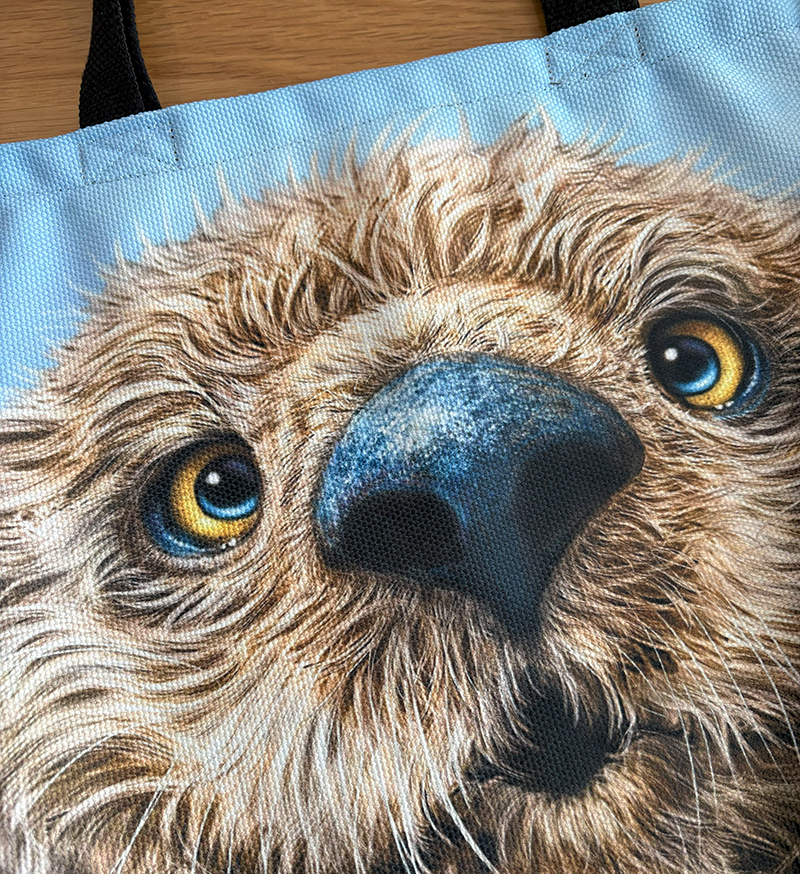 But I’d love to hear your thoughts.
But I’d love to hear your thoughts.
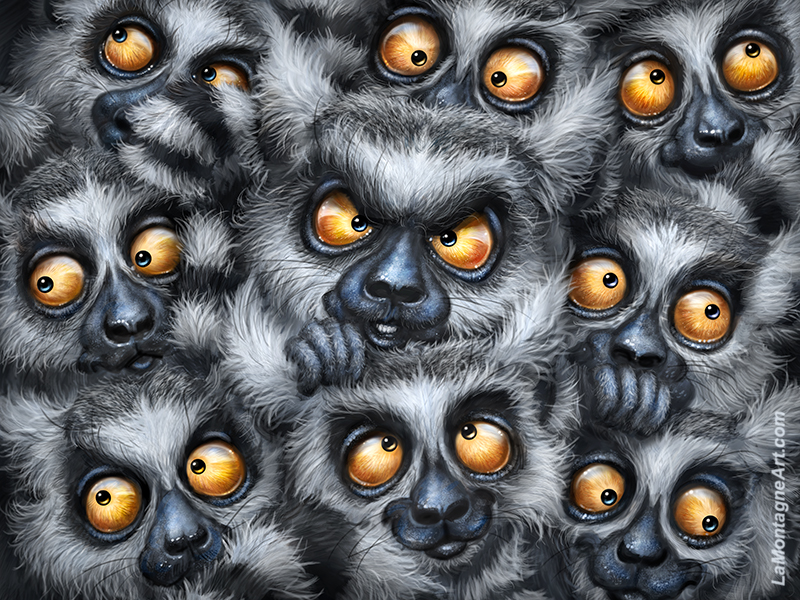 Some paintings come together easily. A reference photo may immediately inspire an idea, I’ll sit down and mock up sketches, and it will almost feel like the image creates itself.
Some paintings come together easily. A reference photo may immediately inspire an idea, I’ll sit down and mock up sketches, and it will almost feel like the image creates itself.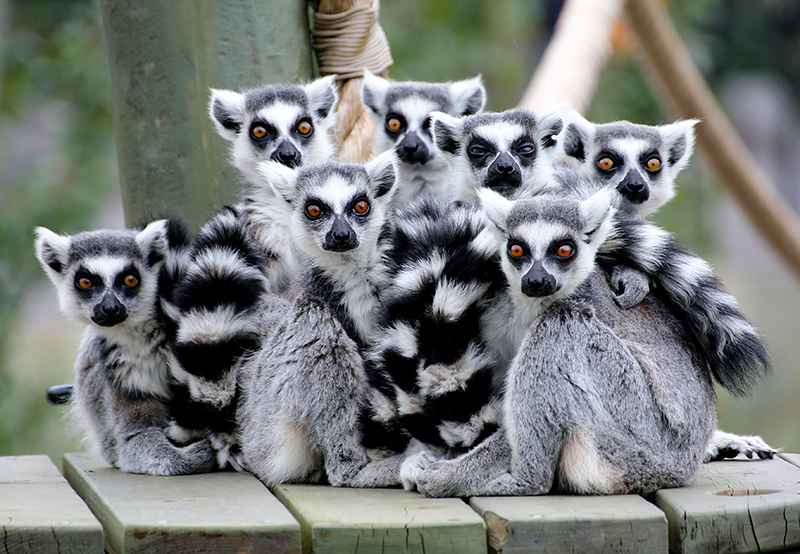 This painting has been something entirely different. Even though I had a clear idea of what I wanted it to look like, I couldn’t get it to feel right. It was inspired by a photo I took at the Calgary Zoo, and I even had the name of the piece before I painted the first brushstroke.
This painting has been something entirely different. Even though I had a clear idea of what I wanted it to look like, I couldn’t get it to feel right. It was inspired by a photo I took at the Calgary Zoo, and I even had the name of the piece before I painted the first brushstroke.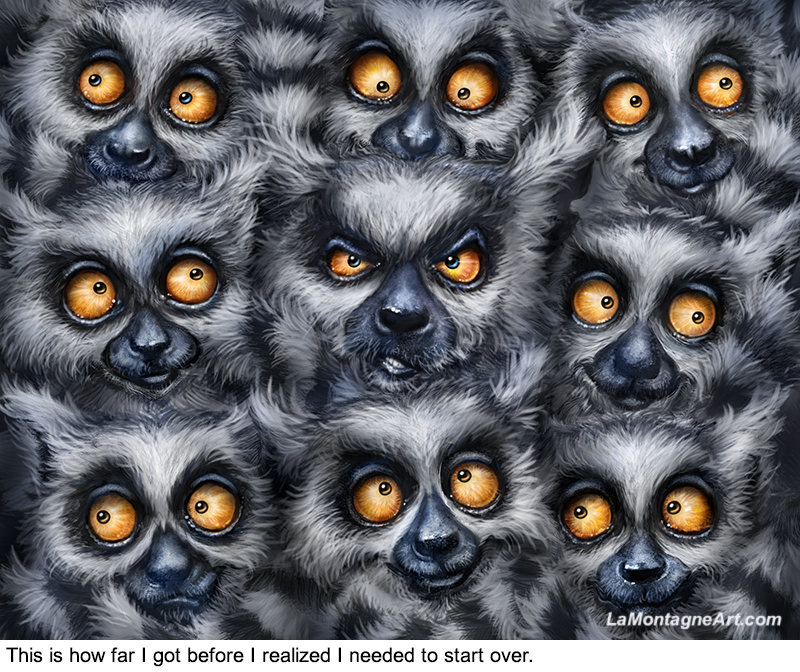
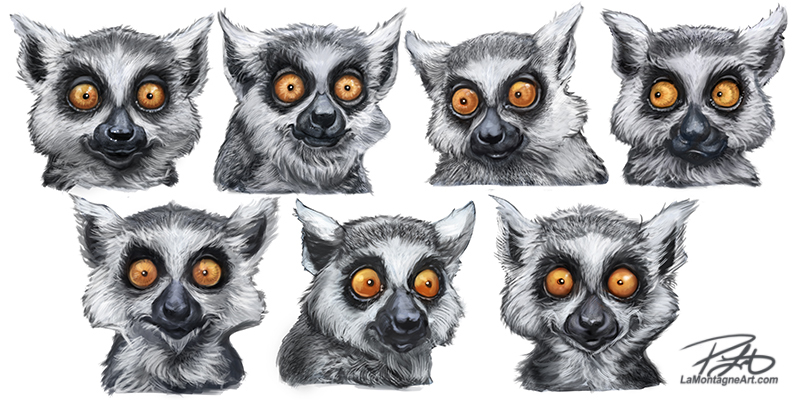 The first go round, I used a specific reference for each lemur I painted and drew them all individually. Even after I assembled them, I kept going back to the individual references for each, and it wasn’t easy to keep track of it all. I made it far too complicated.
The first go round, I used a specific reference for each lemur I painted and drew them all individually. Even after I assembled them, I kept going back to the individual references for each, and it wasn’t easy to keep track of it all. I made it far too complicated.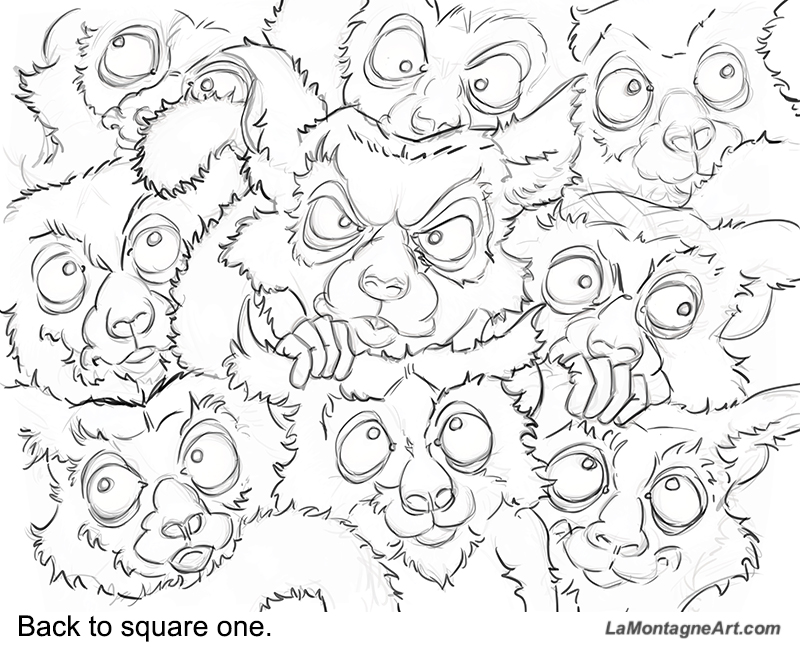 The key to getting this piece back on track was to stop painting individual trees and just paint the forest. Even though this was a challenging painting, with a lot of redrawing and direction changes, I learned from the frustration. These kinds of lessons always contribute to better work in the future.
The key to getting this piece back on track was to stop painting individual trees and just paint the forest. Even though this was a challenging painting, with a lot of redrawing and direction changes, I learned from the frustration. These kinds of lessons always contribute to better work in the future.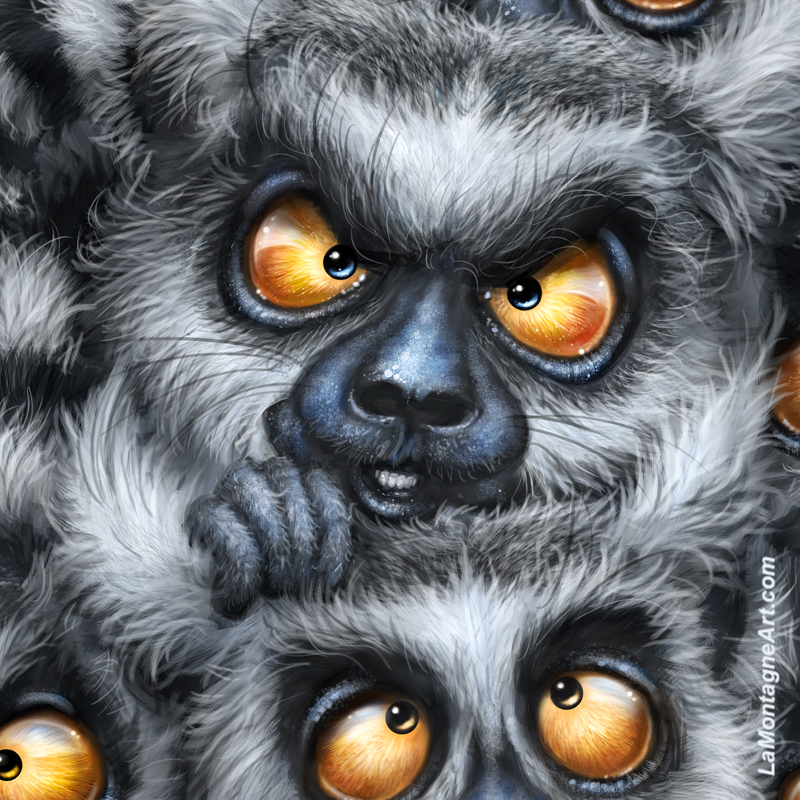 Under these circumstances, my perception of how any finished piece looks is distorted. I have no idea how I feel about this painting and probably won’t for a while. I feel more relief that it’s finally over than satisfaction with the result.
Under these circumstances, my perception of how any finished piece looks is distorted. I have no idea how I feel about this painting and probably won’t for a while. I feel more relief that it’s finally over than satisfaction with the result.
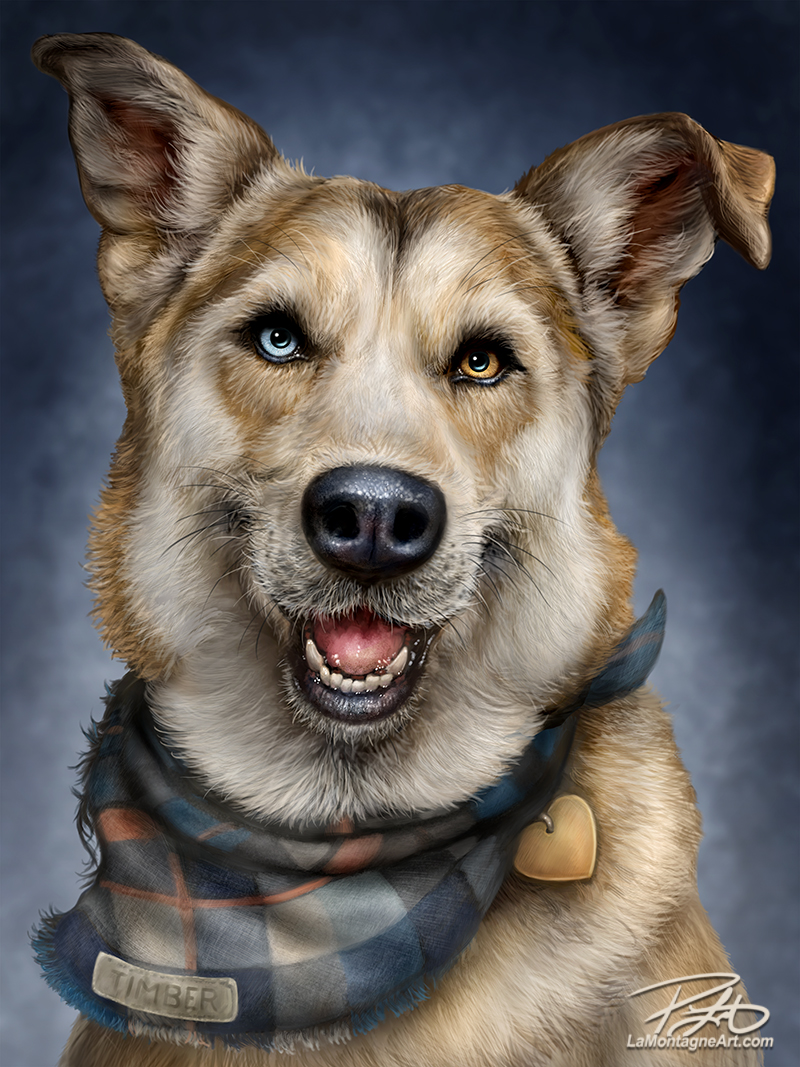 Cindy volunteered with the local SPCA shelter here. And though they had fostered another dog that eventually went to live with her parents in Calgary, they hadn’t found the right one for them until they met Timber.
Cindy volunteered with the local SPCA shelter here. And though they had fostered another dog that eventually went to live with her parents in Calgary, they hadn’t found the right one for them until they met Timber.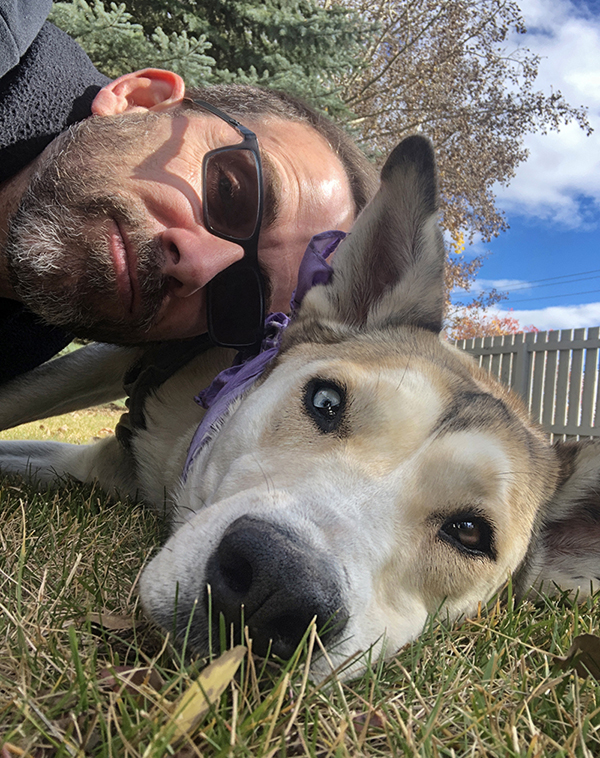
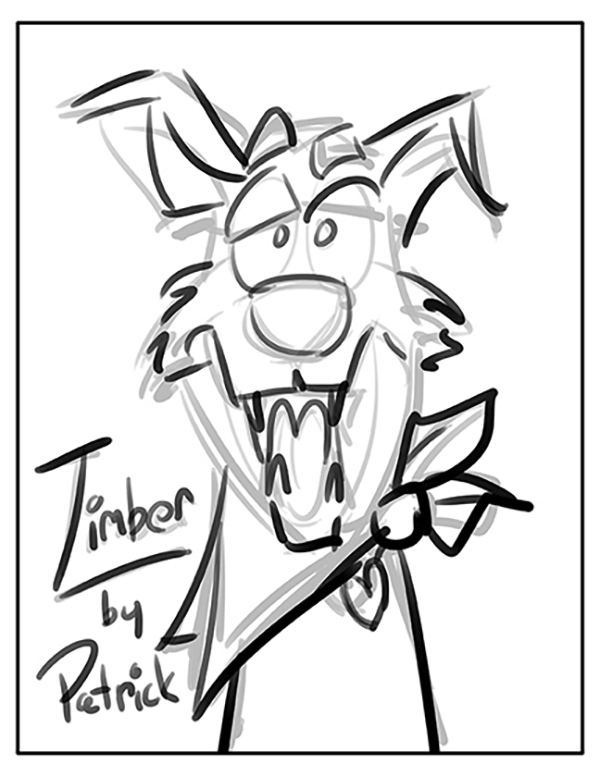 He printed and framed it and sent a photo of it hanging on their wall.
He printed and framed it and sent a photo of it hanging on their wall.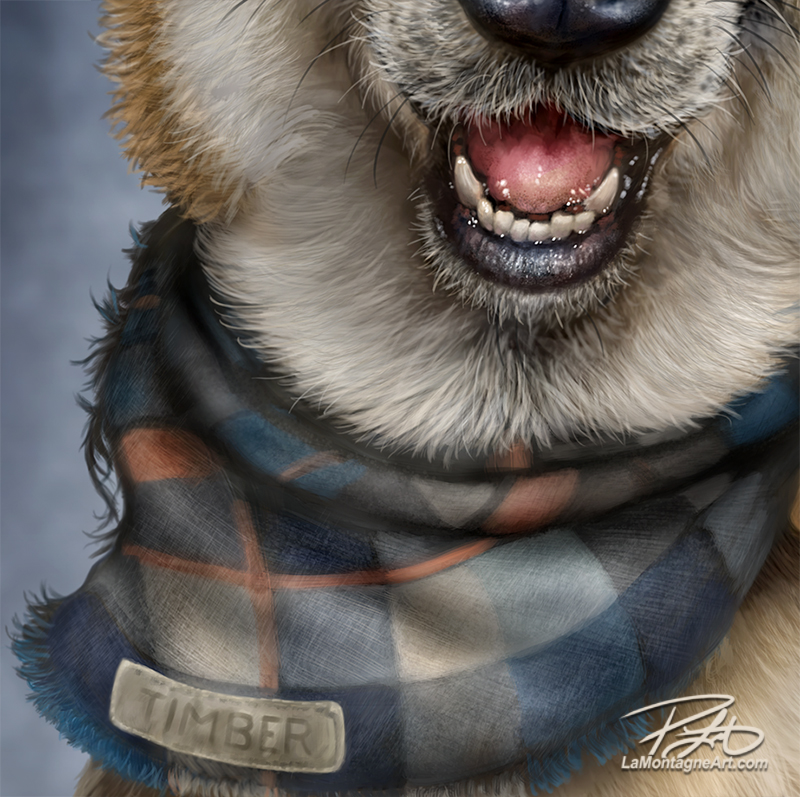 I sent the finished image, and they were thrilled, which made me doubly happy. Because they already had a shadowbox framed 18X24 canvas of my Wolf painting, they wanted Timber’s to match.
I sent the finished image, and they were thrilled, which made me doubly happy. Because they already had a shadowbox framed 18X24 canvas of my Wolf painting, they wanted Timber’s to match.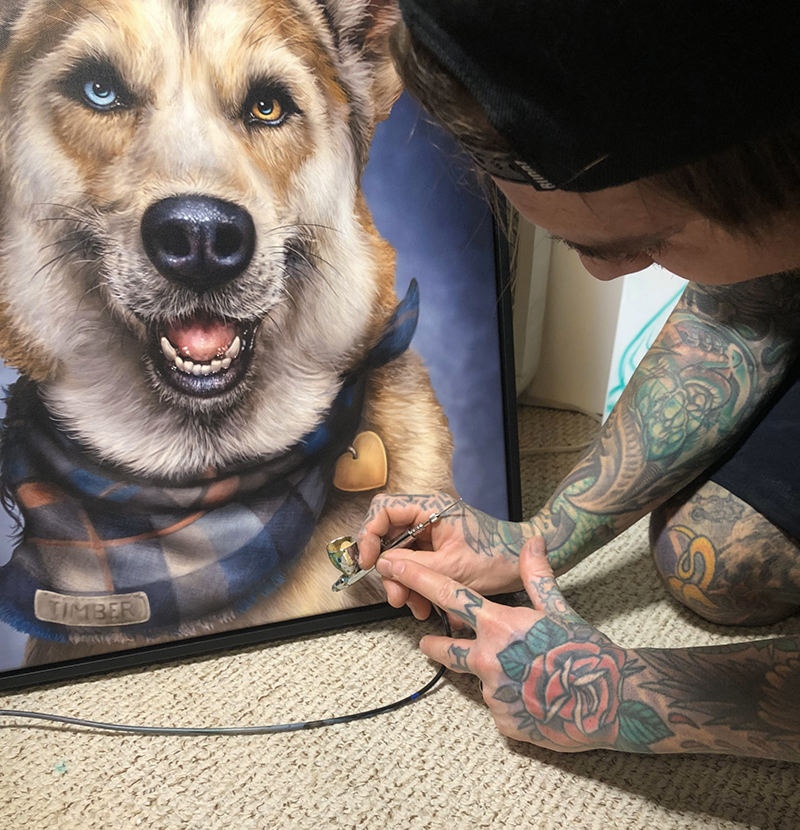 I brought it to Derek’s house a couple of days later, and he matched the colour, finely sprayed the small area a few times, and saved the canvas. You can’t tell there was ever a problem, and you can still see my underlying brush strokes. I held the canvas while he painted with the airbrush, so we staged the above photo after the fact, knowing I’d want to write about it.
I brought it to Derek’s house a couple of days later, and he matched the colour, finely sprayed the small area a few times, and saved the canvas. You can’t tell there was ever a problem, and you can still see my underlying brush strokes. I held the canvas while he painted with the airbrush, so we staged the above photo after the fact, knowing I’d want to write about it.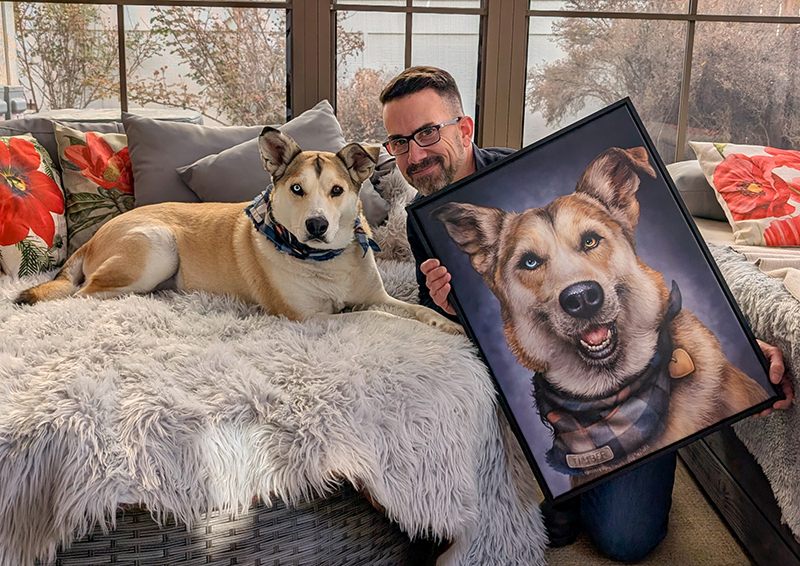 Of course, the best part of any
Of course, the best part of any 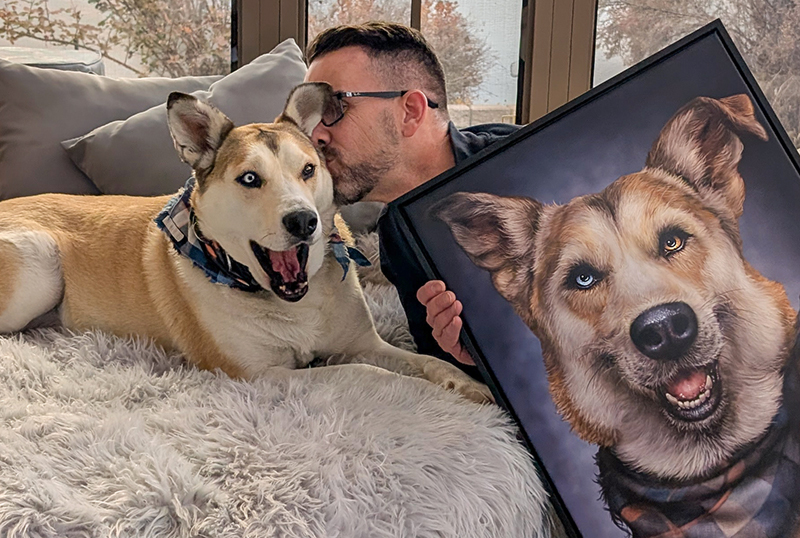


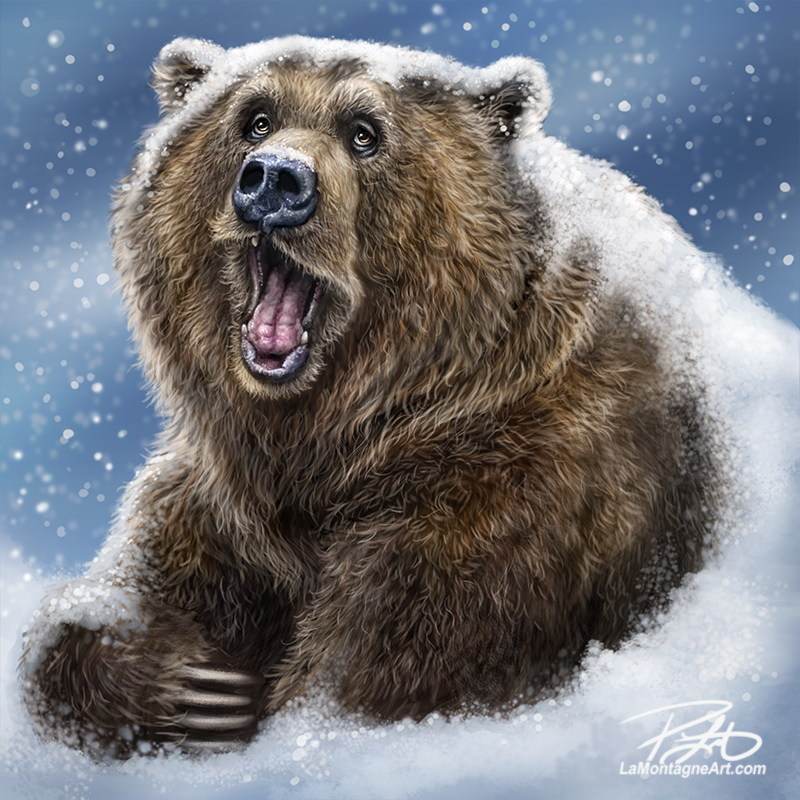 Because I haven’t released a new painting in a while, I did not want to publish yet another post promising something new down the road. So, here’s a new piece: a weary-looking grizzly bear in the snow. I’m calling it Bedtime.
Because I haven’t released a new painting in a while, I did not want to publish yet another post promising something new down the road. So, here’s a new piece: a weary-looking grizzly bear in the snow. I’m calling it Bedtime.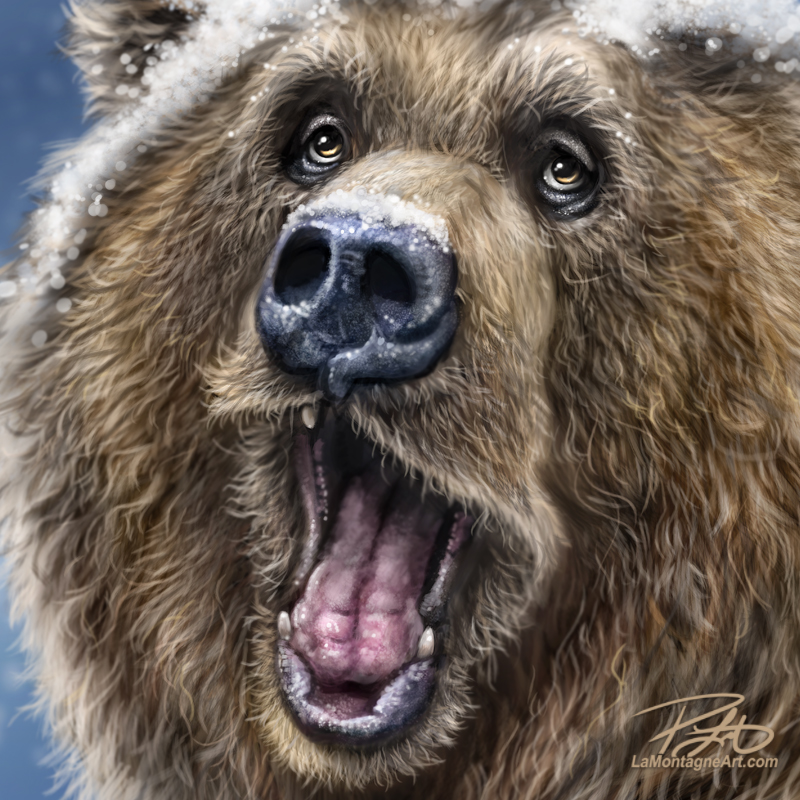
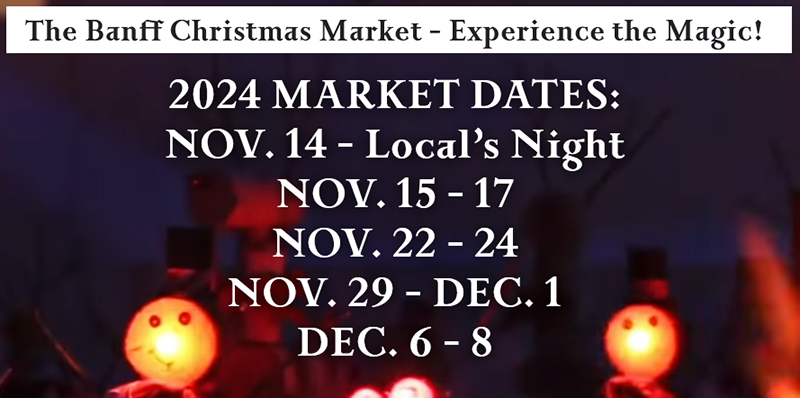
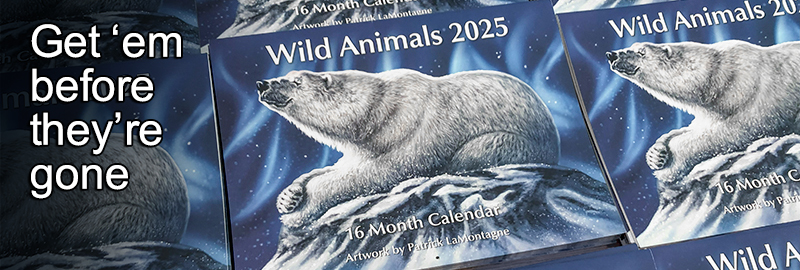

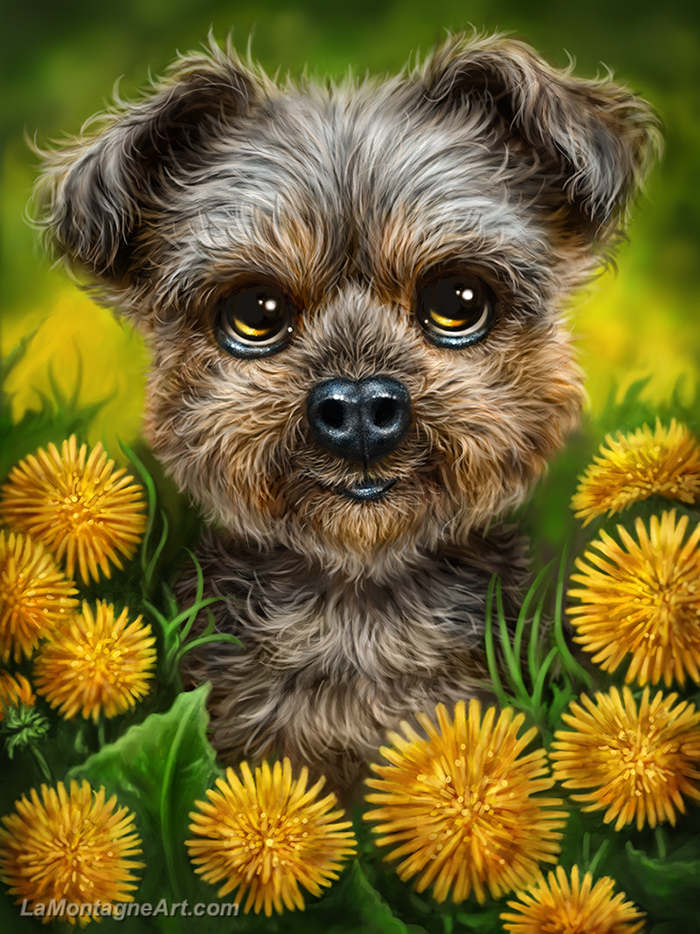
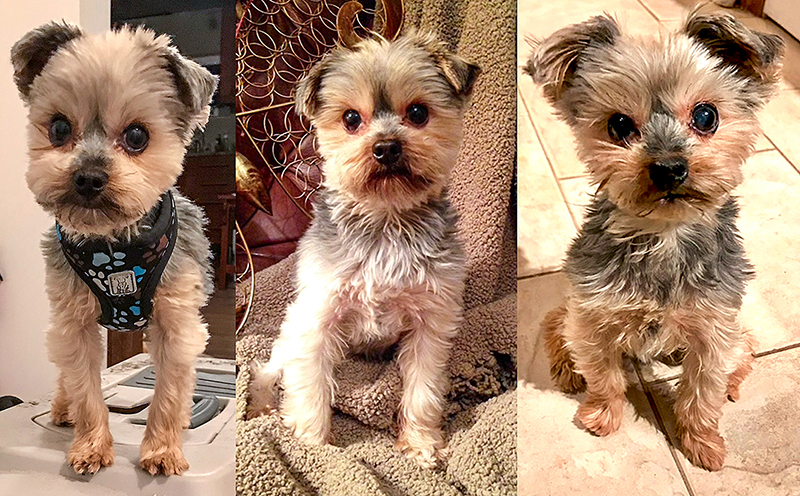
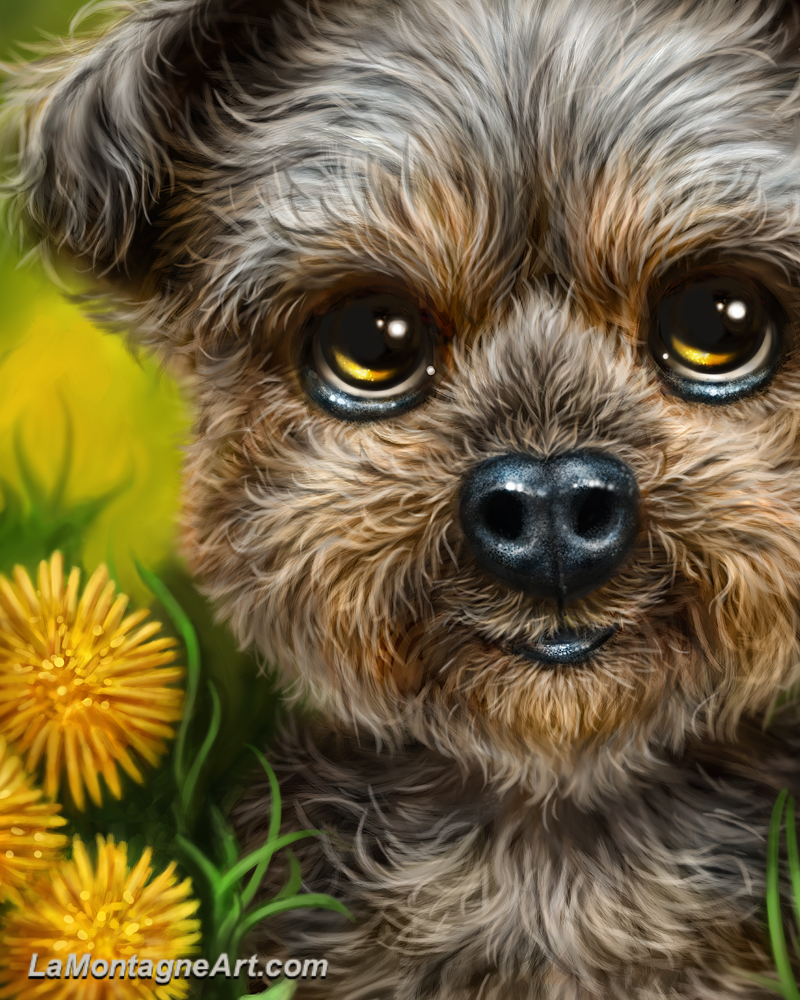 Though Sarah and her spouse live near Edmonton, and I could ship the painting, she and her Mom had planned for a couple of nights in Canmore this past weekend, and I delivered the 18”X24” stretched canvas to their hotel. I took them outside into the sunlight for the reveal so they could see the bright colours and the details. Whether on paper, metal or canvas, my work always looks better in print than on a screen. People have been saying that to me for years. Sarah said it, too.
Though Sarah and her spouse live near Edmonton, and I could ship the painting, she and her Mom had planned for a couple of nights in Canmore this past weekend, and I delivered the 18”X24” stretched canvas to their hotel. I took them outside into the sunlight for the reveal so they could see the bright colours and the details. Whether on paper, metal or canvas, my work always looks better in print than on a screen. People have been saying that to me for years. Sarah said it, too.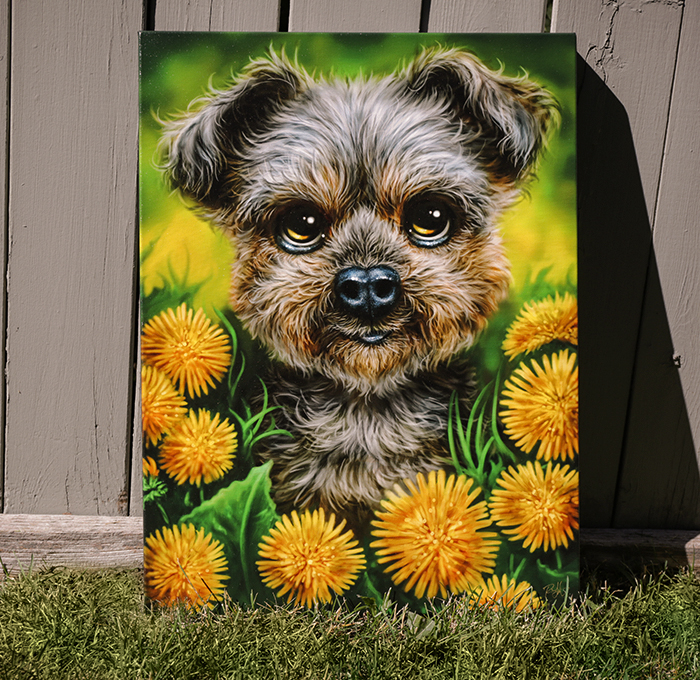

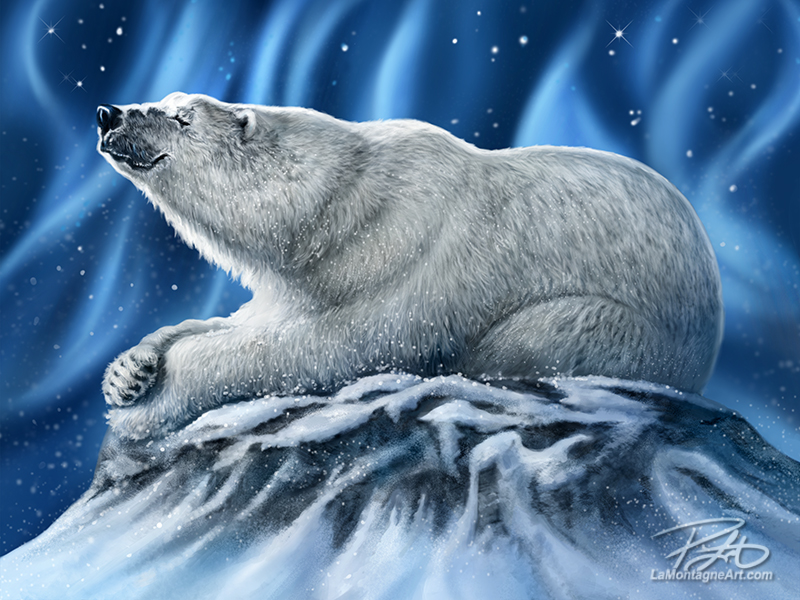 I dropped off a large print and sticker order to the
I dropped off a large print and sticker order to the 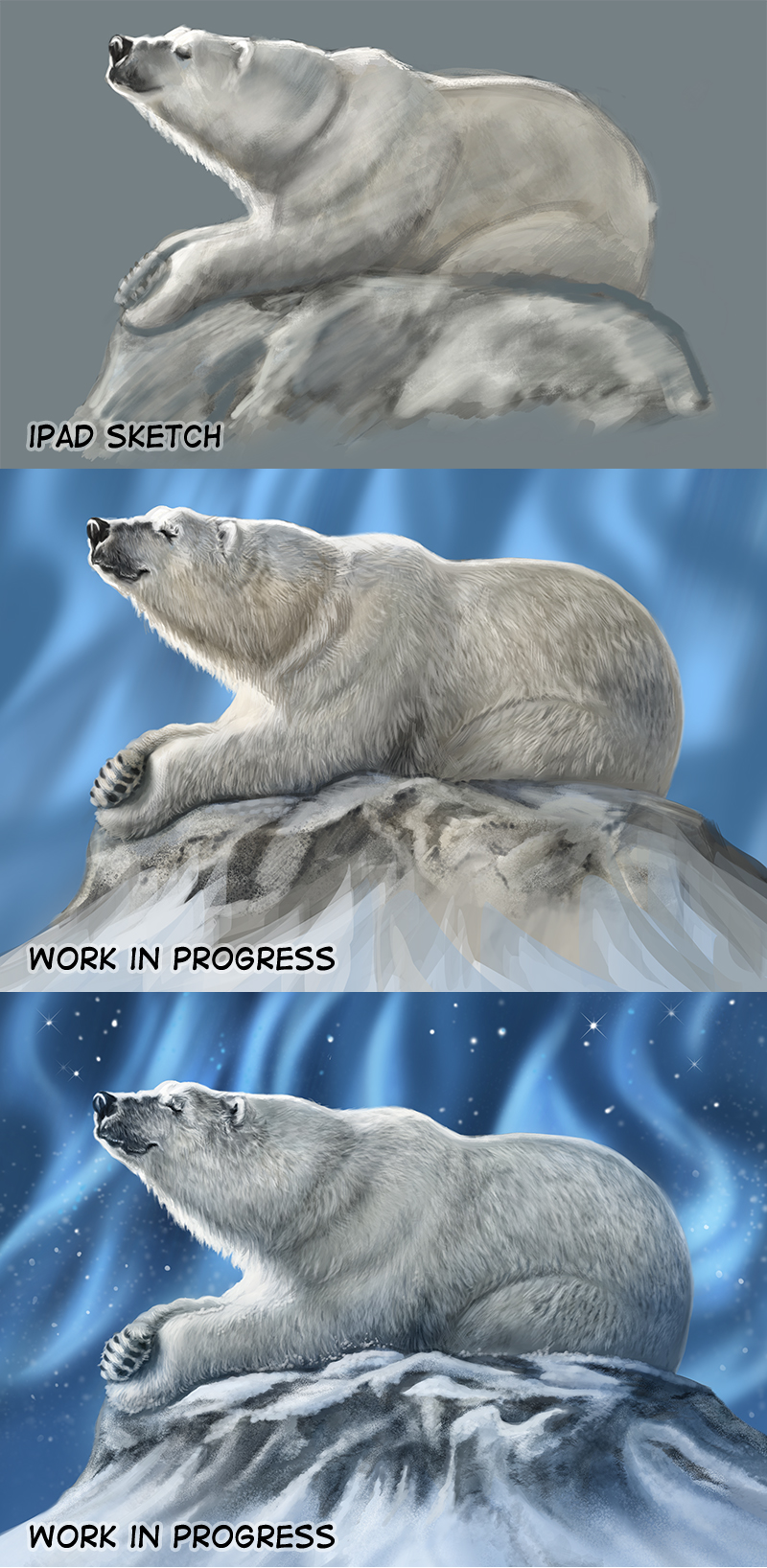
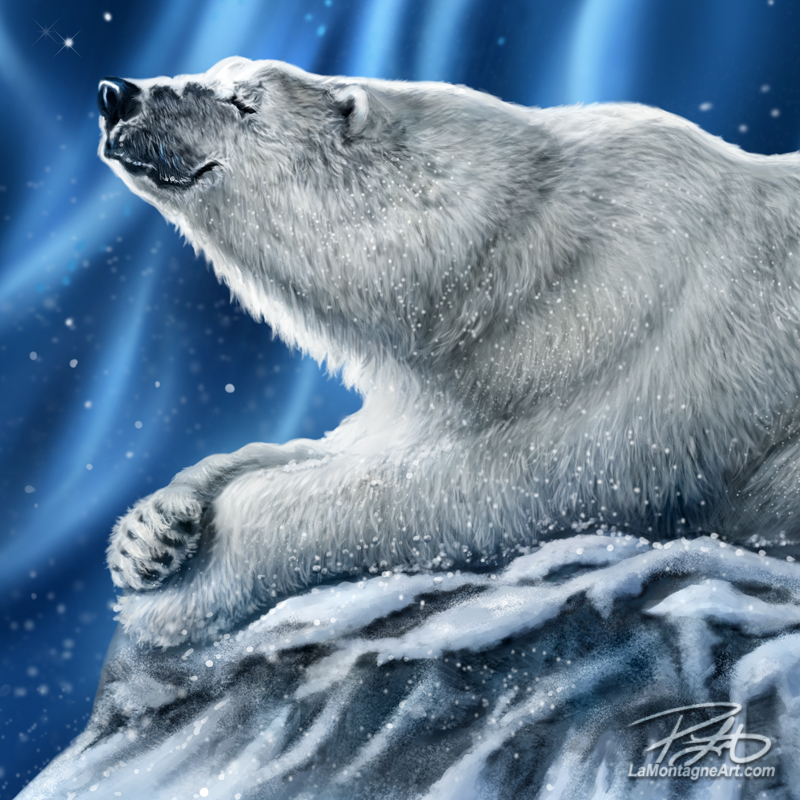 Titles are challenging. While I prefer to come up with something funny or endearing for each painting, I also need to consider my clients and their customers. Simple identifying titles are often better, especially as my portfolio grows. I already have two polar bear paintings
Titles are challenging. While I prefer to come up with something funny or endearing for each painting, I also need to consider my clients and their customers. Simple identifying titles are often better, especially as my portfolio grows. I already have two polar bear paintings 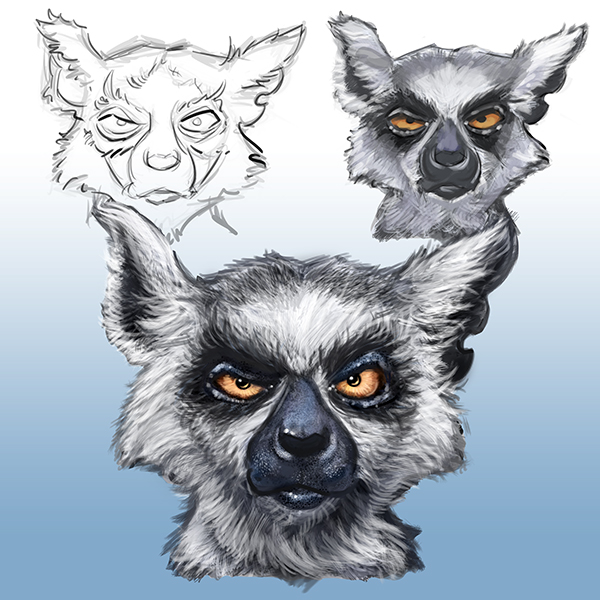
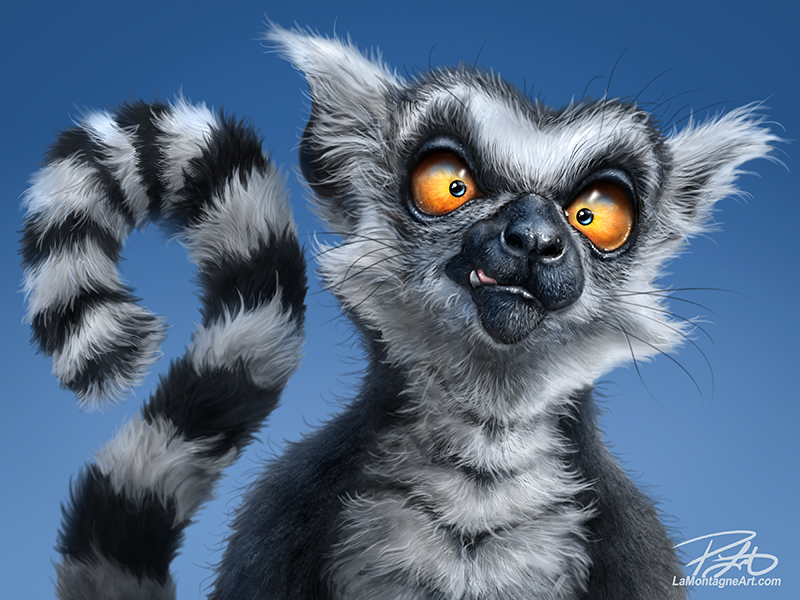
 This photo always makes me chuckle. That evil-looking stare straight down my lens, the squinting focused eyes, the chunk missing from her ear. She reminds me of a gangster saying, “Come closer. See what happens.”
This photo always makes me chuckle. That evil-looking stare straight down my lens, the squinting focused eyes, the chunk missing from her ear. She reminds me of a gangster saying, “Come closer. See what happens.”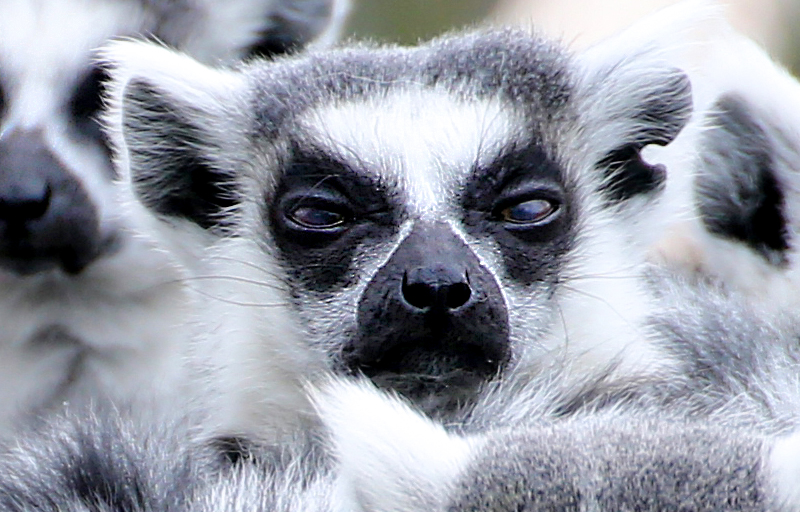
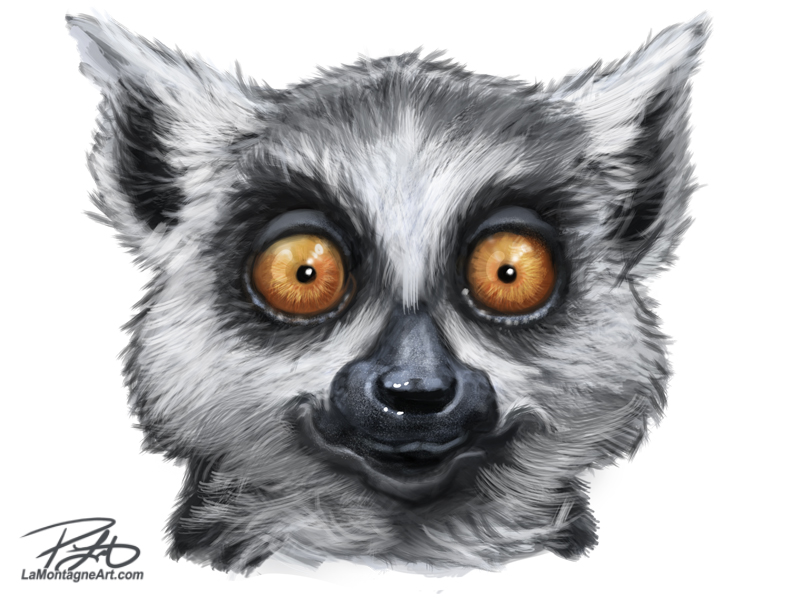 I’m happy with how it’s turned out so far, and I’m also hoping to offer the finished piece as a puzzle later this year.
I’m happy with how it’s turned out so far, and I’m also hoping to offer the finished piece as a puzzle later this year. So, when I’m working on several paintings at once and more involved pieces featuring multiple animals or more detailed backgrounds, paintings that take much longer than a whimsical head and shoulders portrait can be uncomfortable. It feels like I’m not getting enough done.
So, when I’m working on several paintings at once and more involved pieces featuring multiple animals or more detailed backgrounds, paintings that take much longer than a whimsical head and shoulders portrait can be uncomfortable. It feels like I’m not getting enough done.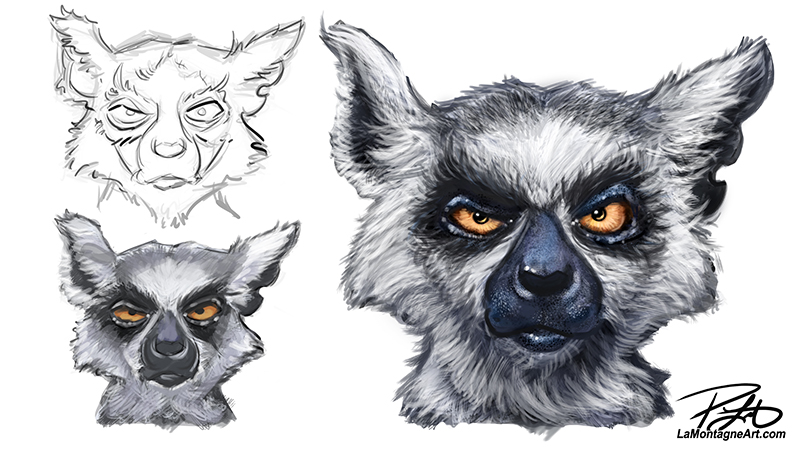 The finished piece will be a lot more detailed than the images in progress you see here. But the vision for what I’m trying to achieve is clear in my mind, and I’m having fun discovering each of these faces.
The finished piece will be a lot more detailed than the images in progress you see here. But the vision for what I’m trying to achieve is clear in my mind, and I’m having fun discovering each of these faces.
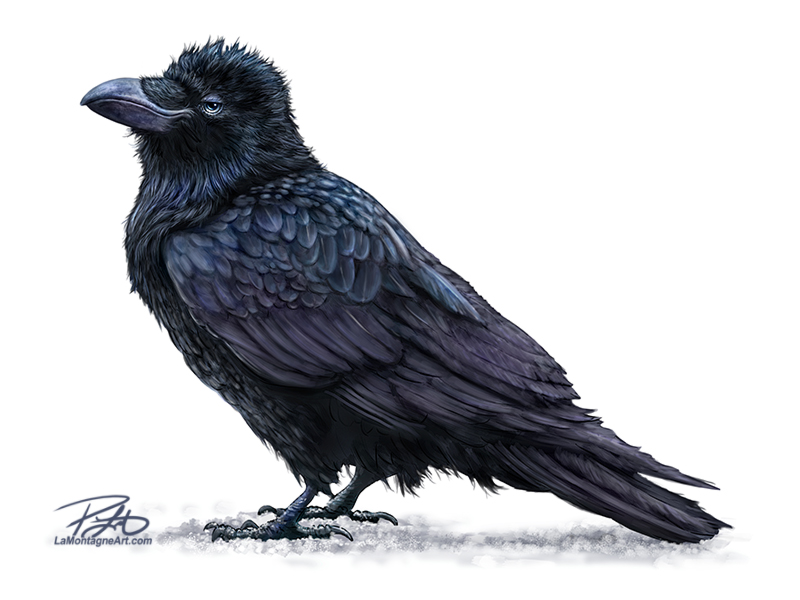 In the late nineties, I worked different jobs at a hotel in Banff for five or six years, from waterslide attendant and manager to front desk agent, night auditor and accounting clerk.
In the late nineties, I worked different jobs at a hotel in Banff for five or six years, from waterslide attendant and manager to front desk agent, night auditor and accounting clerk.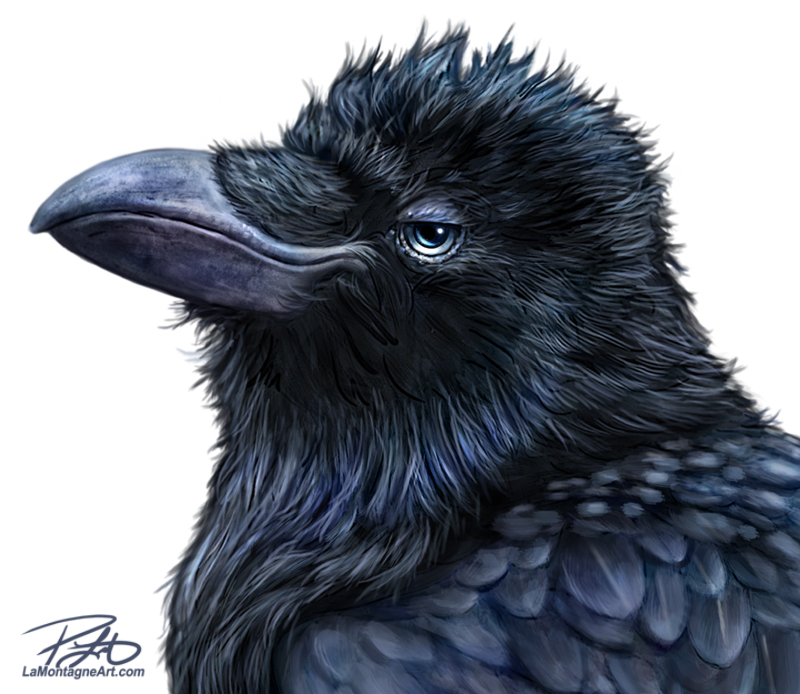 I’ve always liked ravens, and I talked a bit about that in my
I’ve always liked ravens, and I talked a bit about that in my 